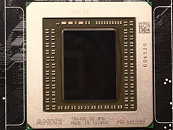- Joined
- Oct 9, 2007
- Messages
- 47,537 (7.47/day)
- Location
- Hyderabad, India
| System Name | RBMK-1000 |
|---|---|
| Processor | AMD Ryzen 7 5700G |
| Motherboard | ASUS ROG Strix B450-E Gaming |
| Cooling | DeepCool Gammax L240 V2 |
| Memory | 2x 8GB G.Skill Sniper X |
| Video Card(s) | Palit GeForce RTX 2080 SUPER GameRock |
| Storage | Western Digital Black NVMe 512GB |
| Display(s) | BenQ 1440p 60 Hz 27-inch |
| Case | Corsair Carbide 100R |
| Audio Device(s) | ASUS SupremeFX S1220A |
| Power Supply | Cooler Master MWE Gold 650W |
| Mouse | ASUS ROG Strix Impact |
| Keyboard | Gamdias Hermes E2 |
| Software | Windows 11 Pro |
AMD's upcoming Radeon R9 380X and R9 380 graphics cards, with which it wants to immediately address the GTX 980 and GTX 970, will be based on a "new" silicon codenamed "Grenada." Built on the 28 nm silicon fab process, Grenada will be a refined variant of "Hawaii," much in the same way as "Curacao" was of "Pitcairn," in the previous generation.
The Grenada silicon will have the same specs as Hawaii - 2,816 GCN stream processors, 176 TMUs, 64 ROPs, and a 512-bit wide GDDR5 memory interface, holding 4 GB memory. Refinements in the silicon over Hawaii could allow AMD to increase clock speeds, to outperform the GTX 980 and GTX 970. We don't expect the chip to be any more energy efficient at its final clocks, than Hawaii. AMD's design focus appears to be performance. AMD could save itself the embarrassment of a loud reference design cooler, by throwing the chip up for quiet custom-design cooling solutions from AIB (add-in board) partners from day-one.

In other news, the "Tonga" silicon, which made its debut with the performance-segment Radeon R9 285, could form the foundation of Radeon R9 370 series, consisting of the R9 370X, and the R9 370. Tonga physically features 2,048 stream processors based on the more advanced GCN 1.3 architecture, 128 TMUs, 32 ROPs, and a 384-bit wide GDDR5 memory interface. Both the R9 370 and R9 370X could feature 3 GB of standard memory amount.
The only truly new silicon with the R9 300 series, is "Fiji." This chip will be designed to drive AMD's high-end single- and dual-GPU graphics cards, and will be built to compete with the GM200 silicon from NVIDIA, and the GeForce GTX TITAN-X it will debut with. This chip features 4,096 stream processors based on the GCN 1.3 architecture - double that of "Tonga," 256 TMUs, 128 ROPs, and a 1024-bit wide HBM memory interface, offering 640 GB/s of memory bandwidth. 4 GB could be the standard memory amount. The three cards AMD will carve out of this silicon, are the R9 390, the R9 390X, and the R9 390X2.
View at TechPowerUp Main Site
The Grenada silicon will have the same specs as Hawaii - 2,816 GCN stream processors, 176 TMUs, 64 ROPs, and a 512-bit wide GDDR5 memory interface, holding 4 GB memory. Refinements in the silicon over Hawaii could allow AMD to increase clock speeds, to outperform the GTX 980 and GTX 970. We don't expect the chip to be any more energy efficient at its final clocks, than Hawaii. AMD's design focus appears to be performance. AMD could save itself the embarrassment of a loud reference design cooler, by throwing the chip up for quiet custom-design cooling solutions from AIB (add-in board) partners from day-one.

In other news, the "Tonga" silicon, which made its debut with the performance-segment Radeon R9 285, could form the foundation of Radeon R9 370 series, consisting of the R9 370X, and the R9 370. Tonga physically features 2,048 stream processors based on the more advanced GCN 1.3 architecture, 128 TMUs, 32 ROPs, and a 384-bit wide GDDR5 memory interface. Both the R9 370 and R9 370X could feature 3 GB of standard memory amount.
The only truly new silicon with the R9 300 series, is "Fiji." This chip will be designed to drive AMD's high-end single- and dual-GPU graphics cards, and will be built to compete with the GM200 silicon from NVIDIA, and the GeForce GTX TITAN-X it will debut with. This chip features 4,096 stream processors based on the GCN 1.3 architecture - double that of "Tonga," 256 TMUs, 128 ROPs, and a 1024-bit wide HBM memory interface, offering 640 GB/s of memory bandwidth. 4 GB could be the standard memory amount. The three cards AMD will carve out of this silicon, are the R9 390, the R9 390X, and the R9 390X2.
View at TechPowerUp Main Site



 But it will be worth it... somewhat.
But it will be worth it... somewhat. 




